Grant money will lay roots for tree planting in South L.A.
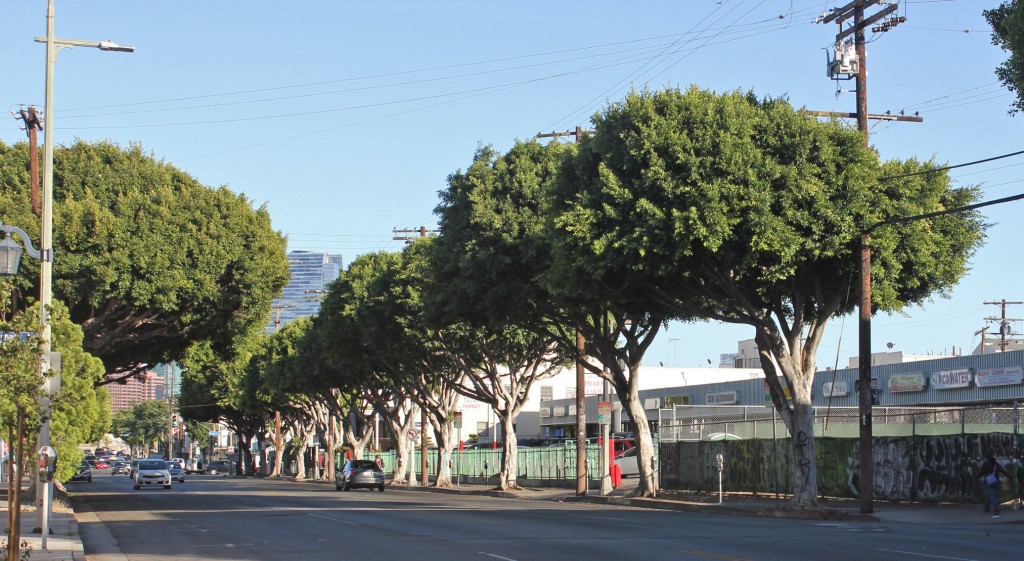
The goal of the grant KYCC received is to ensure half of the possible tree sites in South Los Angeles and Pico-Union are planted, creating consistent shade coverage. | Rachel Cohrs, Intersections South L.A.
One community organization has a grant to plant trees in South Los Angeles, but first it has to convince local residents that picturesque, tree-lined streets aren’t just for neighborhoods in Beverly Hills.
“If you’re struggling on a daily basis, trees might not be the first things you’re thinking about. These communities deal with crime, a large homeless population, illegally dumped trash, graffiti, and gang violence … Most people are just trying to get by,” said Ryan Allen, Environmental Services Manager of Koreatown Youth and Community Center (KYCC).
However, Allen and the staff at KYCC know that planting trees can have positive effects in low-income communities. The benefits of having densely planted trees include reduction of energy costs, creation of shade, and the beautification of neighborhoods.
In neighborhoods like South Los Angeles and Pico-Union, which both scored poorly in air quality evaluations, planting trees can help reduce the effects of pollution by removing toxins from the air.
“One tree on its own will do those things, but there is the idea of strength in numbers,” Allen said.
KYCC received nearly $330,000 in grant money from the California Department of Forestry and Fire Protection to make the vision of dense tree cover a reality in the South Los Angeles and Pico-Union areas.
The funds stem from a cap-and-trade program passed in California in 2006 to reduce greenhouse gas emissions. Under cap-and-trade, companies have to pay for emissions over a certain limit, increasing the incentive to reduce air pollution. At least 25 percent of the revenue from the program is distributed to greenhouse gas emissions-reducing projects in low-income neighborhoods.
South Los Angeles struggles with high levels of pollution that are compounded by other problems. A case study of the area shows that the South Los Angeles area is “disproportionately burdened” by poverty, unemployment and linguistic isolation.
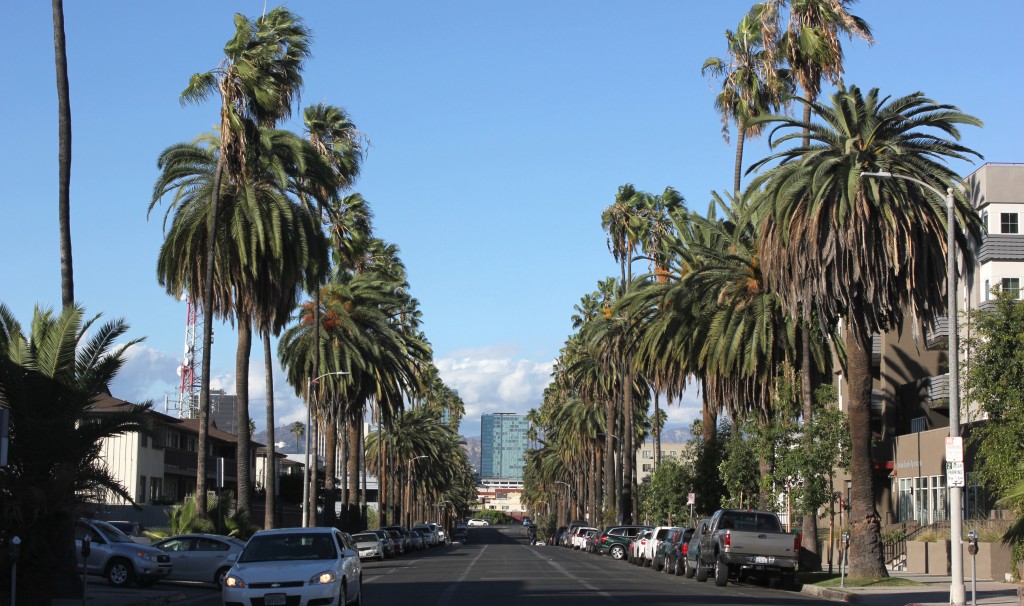
KYCC helped plant small trees between other trees to create shade cover on this street in South Los Angeles. | Rachel Cohrs, Intersections South L.A.
KYCC got the grant to plant 1,120 trees over a four-year period starting in 2016. Its goal in the project is to use the grant to see that at least half of the potential tree sites on neighborhood streets planted.
After the initial planting, KYCC will provide funding to maintain the trees for the first three years. After that, the trees will have grown substantially and will need less maintenance work. Despite the benefits of having trees planted, not everyone is on board with the plan.
Community members have voiced concerns about tree roots breaking up sidewalks, having to water, prune and maintain the trees, and the trees dropping leaves. Allen also cited a mental barrier that trees might not fit the culture of South Los Angeles neighborhoods. In the past, trees planted incorrectly caused sidewalks to crack and fall into disrepair.
That’s what the KYCC grant is for. Beyond buying trees to plant, the organization plans to reduce barriers and address community concerns. If community members voice worries, then KYCC can use some of the grant money to remove stumps or invasive trees, repair sidewalks, check sewer lines, and other incentives.
“We are going to try to address different concerns people could have so they don’t have reason to say no,” Allen said.
KYCC is qualified to mitigate these potential issues because the organization has been involved in tree planting efforts since 1999, and has expertise in selecting the right tree species and planting them in the right places to ensure they won’t damage sidewalks.
The task of physically getting the trees planted is expected to be an undertaking that will require community engagement. Previously, KYCC has gone door to door knocking and asking if residents would like a tree. The new grant is based on individuals taking responsibilities for their own streets and talking with their neighbors to get trees planted.
KYCC also plans to help organize community planting events to help get residents’ hands dirty and encourage involvement with the cause.
“It takes somebody dedicated, and a certain amount of legwork to work with neighborhood and to get people interested,” Allen said.
KYCC will be working through community organizations to streamline the process. Allen said the team is just now beginning to work with other organizations from existing partnerships and make new connections.
One new organization KYCC could be partnering with for a tree planting project on a different grant is the Redeemer Community Partnership.
Redeemer has an independent initiative focused on Jefferson Boulevard to “Make Jefferson Beautiful” by beginning a tree canopy, repairing sidewalks, and integrating bike lanes for safer transportation. Niki Wong, the lead community organizer at Redeemer Community Partnership, said she wants all the area surrounding USC to benefit from the university investment.
Tree cover on Jefferson on the USC side versus the community side
“USC is right next door. Vermont Avenue kind of serves as this invisible line between two cities….Part of what we are hoping to do is kind of dissolve that line and make the closeness beneficial for folks in the neighborhood,” Wong said.
Wong said one of the most important benefits of partnering with KYCC on a tree planting project is the commitment to long-term maintenance and community engagement. The grant Wong applied for through the Los Angeles Neighborhood Initiative would maintain 15 trees, plant 14 new trees, and replace two dead trees. Although the shade will not be provided immediately, within a few years well-tended trees will provide the full benefits.
Besides the environmental advantages of having trees planted, Wong also said attractive tree cover could encourage residents to go outside more and help draw businesses to the area.
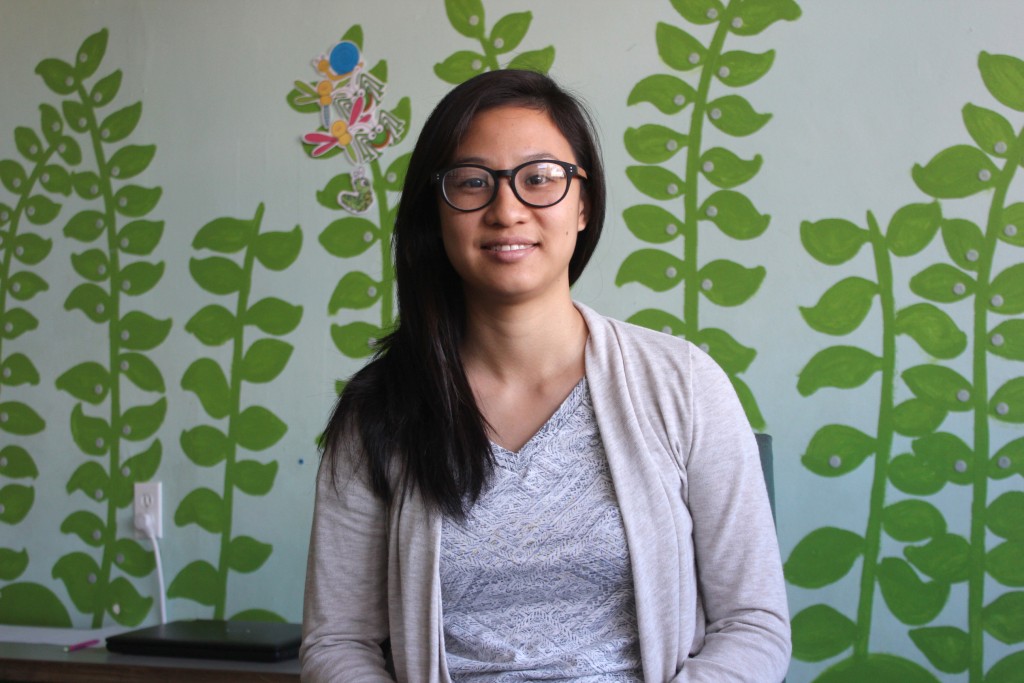
Niki Wong works with Redeemer Community Partnership to get grants to make Jefferson Boulevard safer and more beautiful. | Rachel Cohrs, Intersections South L.A.
Further, Wong pointed out that even though grant money is being set aside to help remedy these problems, under-resourced communities may not have the time or expertise to complete complicated grant application processes.
“This is for a community that has been overlooked, and at the bottom of the priority list for all sorts of improvements. Our crosswalks are faded, our sidewalks are broken, and a lot of tree wells are empty or have dead trees in them. It’s just very clear that there has been neglect,” Wong said.
Applications for annual grants will be available for the KYCC grant funds in the spring. Community organizations can apply and individuals can also get support to build up a tree canopy in South Los Angeles. Both Wong and Allen emphasized that in order to move forward with the projects, community support and engagement is essential.
“We want to be helping communities and residents to make their vision for a better neighborhood happen,” Allen said.
Neighborhood council to take action on Reef Project report
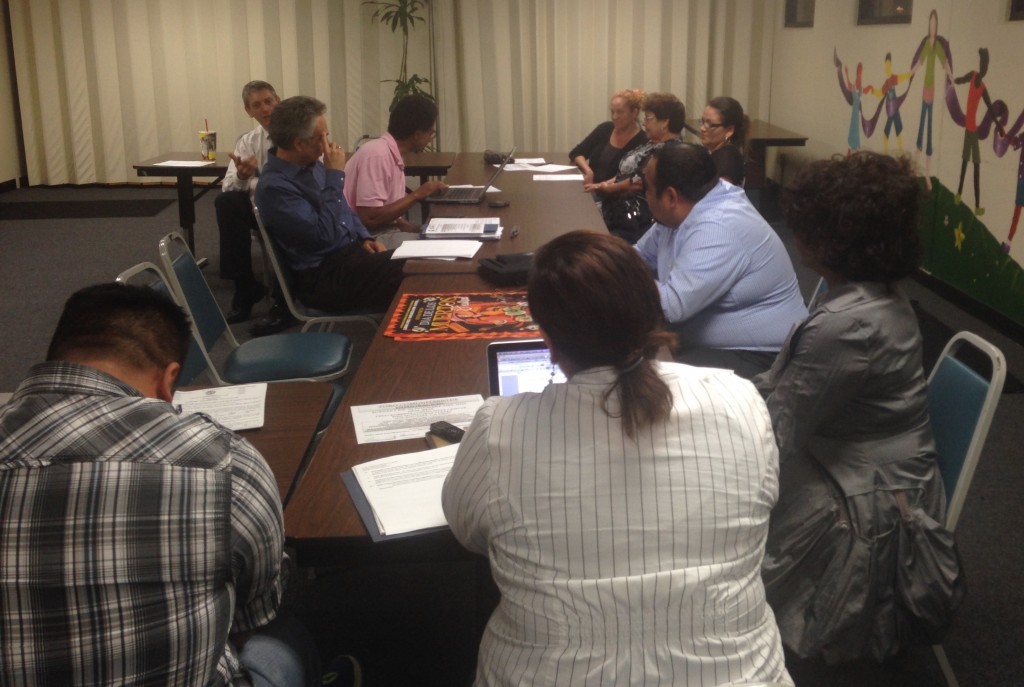
The South Central Neighborhood Council and community members discussed possible courses of action on the Reef Project Environmental Impact Report on Tuesday, October 20, 2015. | Rachel Cohrs, Intersections South L.A.
With the deadline for public comment on more than 800 pages of documentation on the proposed Reef Project development approaching, the South Central Neighborhood Council said it needs more time to sort through the information.
“The language is hard to understand, and it’s just too much,” said council member Martha Sanchez. “I want to be able to understand what I’m reading. . .I want to have time for an expert who knows more to explain what this means to community members.”
The Reef Project is a $1.2 billion development of high-rise condos, commercial space, and a hotel to be erected in South LA. The project has received some pushback from community residents.
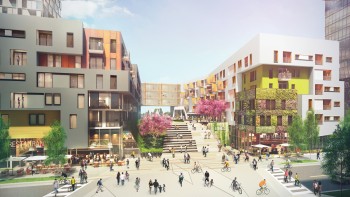
A rendering of the proposed $1.2 billion Reef Project development. | Courtesy of Gensler and PATTERNS
The paperwork under review is the Environmental Impact Report that describes the different community impacts the project could have on nearby residents. The Los Angeles Department of City Planning’s summary of the report describes that the Reef Project’s largest disruptions will affect local aesthetics, air quality, noise, traffic and transportation.
The report, released Sept. 17, is available solely in English, and is only available by either visiting the Department of City Planning office, visiting one of four library locations, or paying $7.50 for a copy on CD.
“Looking at this neighborhood, for [the document] only to be provided in English is absurd. We have lots of monolinguistic Spanish-speaking people around here. It’s hard enough for the average person to understand, not to mention if they don’t speak the language,” council member John Parker said.
The South Central Neighborhood Council has authorized a committee to submit a public comment before the Nov. 2 deadline. The statement will be based on community input the council has gathered since its town hall meeting last month. The exact content has yet to be determined.
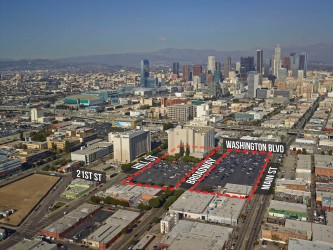
A visual map of the location of the Reef Project south of downtown Los Angeles. | Courtesy of Gensler and PATTERNS
The council also plans to submit a request to the city to extend the deadline, but the prospects of success look grim after another organization’s request was denied.
Reef Project representative Will Cipes said that although the official deadline for comment may pass on the report, the developers will still be open to community insight regarding a community benefits package attached to the project.
According to Cipes, however, the community benefits package with the city isn’t quite concrete.
“We have talked about the broad concept of an agreement [on a benefits package] but we have not talked specifics,” Cipes said.
Cipes estimated that the official city council vote on the development will likely be at least six months away.
The Environmental Impact Report didn’t measure how much potential displacement the existence of market-rate apartments could cause in the surrounding area. Preliminary analysis conducted by SAJE, a local nonprofit advocating for tenant rights and affordable housing, identified 4,445 individuals within a two-mile radius of the Reef Project who could be at “very high” or “high” risk for financial strain and/or displacement if the development is built.
To educate community members and provide a place for residents to voice concerns about the project, the South Central Neighborhood Council is organizing a community forum on gentrification Wednesday, Oct. 28 at Santee Education Complex at 6 p.m.
“We want to do something that is really going to benefit people,” South Central Neighborhood Council President Jose Reyes said. “We don’t want to do something just to say we did something.”
Residents push to clean up illegal trash dumpings

Active Recycling has taken more than 200,000 pounds of illegally dumped trash off LA streets . | Photo by Rachel Cohrs
Active Recycling, a private recycling company on West Slauson Avenue, is offering free trash drop-offs for up to 2,000 pounds on the first trip. Normally, a similar drop-off could cost around $100. Active Recycling then sorts out the recyclable goods.
“Everyone thinks I’m crazy for doing it. It’s costing me a lot of money. What I’m getting out of it is a cleaner city for my children, my grandchildren, and for other people’s children,” Errol Segal, who takes care of day-to-day operations as a senior consultant for Active Recycling, said.
In the first two weeks of the program, 220,000 pounds of illegally dumped trash were taken to Active Recycling. Drop-offs, however, have slowed down in the recent weeks.
While the program was originally intended to last from Aug. 28 to Oct. 15, Segal has decided to extend the offer indefinitely as long as people continue dropping off trash.
“I’m not going to stop for as long as it takes to clean up the city,” Segal said.
Illegal trash dumping has been a nuisance in Los Angeles in recent years, many said. Residents from all over the city take truck-loads of trash to South Central alleys that have become dumping grounds.
Local resident Charletta Butler said near her home, illegally dumped trash has piled up for months. She described rusted cars without wheels and abandoned refrigerators that are languishing in a nearby alley. While she said residents put in a service request more than a month ago, the mess still has not been cleaned up.
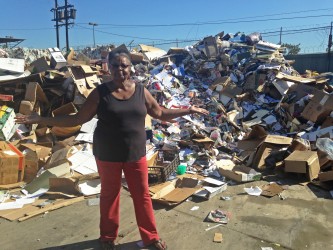
Resident Charletta Butler poses with community trash that has been brought to Active Recycling. | Photo by Rachel Cohrs
“If someone came from out of state came to visit, they would go away saying this is primitive. This is third world living,” Butler said.
The illegal dumping also causes safety concerns because emergency response vehicles can’t navigate alleys filled with truck loads of trash.
After a City Administrative Office report released in March found that Los Angeles lags behind other cities in trash can availability and street cleanliness, Mayor Eric Garcetti signed an executive order to add 5,000 trash cans, add a third “strike team” to respond to illegal dumping requests and to create a cleanliness index to measure progress.
Segal doesn’t think adding more trash cans will solve the problem, since much of the refuse is too large to fit in them.
“What people are dumping illegally on our streets and alleys and sidewalks in vacant lots and by the highways is not a trash can full. If that were all it was it wouldn’t be much of a problem,” Segal said.
In mid-August, city officials came under fire again after Los Angeles Bureau of Sanitation statistics showed that the city responded at a significantly lower rate to clean up requests in low-income neighborhoods. The L.A. Times reported that while the city responded to 99 percent of requests for trash clean-ups in some areas of the city, more than one-third of requests in dozens of neighborhoods in Central, Northeast and South L.A. were ignored.
However, the L.A. Times also reported that the percentage of requests that are not responded to overall has decreased since Garcetti took office, from 27 percent in the previous two and a half years to 15 percent.
Active Recycling hosted five press conferences about their free drop-off program. While local media outlets did attend, no city officials or representatives were present, which frustrated some local residents.
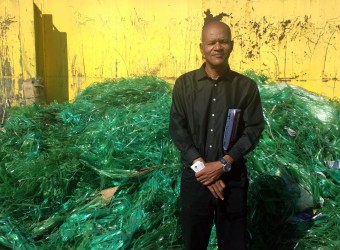
Leonard Delpit along with the Empowerment Congress Central Area Neighborhood Development Council is educating people on illegal dumping in South LA. | Photo by Rachel Cohrs
Empowerment Congress Central Area Neighborhood Development Council member Leonard Delpit said people should be educated that these opportunities exist, and recognition by city officials is a key part of getting public attention.
“Our mayor mentioned that he wants a clean street initiative. We haven’t seen the mayor, but we support the idea. The concept is correct,” Delpit said.
Segal did receive an email from Greg Good, the Director of Operations and Executive Officer for City Services stating that “The Mayor -— and all of us — greatly appreciate and support [Segal’s] efforts.”
A request for comment from the mayor’s office by Intersections was not returned.
Delpit said further options he would like to see the city pursue are more low-cost drop off opportunities at city-owned yards and camera surveillance of alleys to enforce dumping ordinances.
No matter what options are pursued, Butler said South Los Angeles residents need the problem addressed now.
“We need answers. We need to have it done, and have it done immediately. We don’t need a clean-up when our elected officials want to bring in the Olympics in 2024. We need it now,” Butler said.
Some South LA residents express uncertainty with billion dollar development
South LA residents are weighing the benefits of a proposed $1.2 billion development that promises to add condos, a hotel, a grocery store and hundreds of permanent jobs to the community.
About 60 community members came to the South Central Neighborhood Council’s town hall meeting to voice their opinion on The Reef Project. The project is an expansion around the current Reef building, which serves as a space for small creative businesses. Parking lots cover the rest of the two-block area bordered by Hill Street, Washington Boulevard, Main Street and 21st Street.
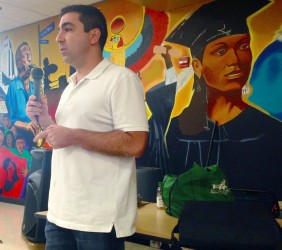
Attorney Edgar Khalatian said the REEF Project will support affordable housing. | Photo by Rachel Cohrs
The development also would add a pharmacy, retail space, a bank and open pedestrian spaces.
If the project is approved, it is projected to create 2,758 temporary construction jobs and 751 permanent part- and full-time positions, most of which would be in the hotel. Thirty percent of the construction and hotel jobs would be filled by people living within a five-mile radius. An apprenticeship program is being developed through Los Angeles Trade Technical College to provide training for local residents to qualify for the positions.
Out of dozens of resident questions submitted, a central question emerged: What’s in it for us? Residents at the meeting on Sept. 19 at Santee High School voiced concerns that the project wouldn’t cater to their needs.
“They are trying to make us feel like we are privileged that they are coming here, but they should be coming in on our terms and asking what we want it to look like,” said Adriana Cabrera, education representative for the Central-Alameda Neighborhood Council and co-founder of Empowering Youth in South Central.














